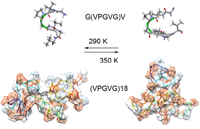| Title | Molecular description of the LCST behavior of an elastin-like polypeptide |
| Publication Type | Journal Article |
| Year of Publication | 2014 |
| Authors | Li, NK, García Quiroz, F, Hall, CK, Chilkoti, A, Yingling, YG |
| Journal | Biomacromolecules |
| Pagination | ASAP |
| Date Published | 08/2014 |
| ISSN | 1526-4602 |
| Abstract | Elastin-like polypeptides (ELPs) with the repeat sequence of VPGVG are widely used as a model system for investigation of lower critical solution temperature (LCST) transition behavior. In this paper, the effect of temperature on the structure, dynamics and association of (VPGVG)18 in aqueous solution is investigated using atomistic molecular dynamics simulations. Our simulations show that as the temperature increases the ELP backbones undergo gradual conformational changes, which are attributed to the formation of more ordered secondary structures such as β-strands. In addition, increasing temperature changes the hydrophobicity of the ELP by exposure of hydrophobic valine-side chains to the solvent and hiding of proline residues. Based on our simulations, we conclude that the transition behavior of (VPGVG)18 can be attributed to a combination of thermal disruption of the water network that surrounds the polypeptide, reduction of solvent accessible surface area of the polypeptide, and increase in its hydrophobicity. Simulations of the association of two (VPGVG)18 molecules demonstrated that the observed gradual changes in the structural properties of the single polypeptide chain are enough to cause the aggregation of polypeptides above the LCST. These results lead us to propose that the LCST phase behavior of poly(VPGVG) is a collective phenomenon that originates from the correlated gradual changes in single polypeptide structure and the abrupt change in properties of hydration water around the peptide and is a result of a competition between peptide-peptide and peptide-water interactions. This is a computational study of an important intrinsically disordered peptide system that provides an atomic-level description of structural features and interactions that are relevant in the LCST phase behavior. |
| DOI | 10.1021/bm500658w |
| Short Title | Biomacromolecules |
